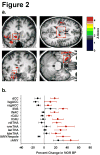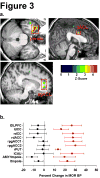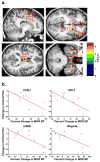Traditional Chinese acupuncture and placebo (sham) acupuncture are differentiated by their effects on mu-opioid receptors (MORs)
- PMID: 19501658
- PMCID: PMC2757074
- DOI: 10.1016/j.neuroimage.2009.05.083
Traditional Chinese acupuncture and placebo (sham) acupuncture are differentiated by their effects on mu-opioid receptors (MORs)
Abstract
Controversy remains regarding the mechanisms of acupuncture analgesia. A prevailing theory, largely unproven in humans, is that it involves the activation of endogenous opioid antinociceptive systems and mu-opioid receptors (MORs). This is also a neurotransmitter system that mediates the effects of placebo-induced analgesia. This overlap in potential mechanisms may explain the lack of differentiation between traditional acupuncture and either non-traditional or sham acupuncture in multiple controlled clinical trials. We compared both short- and long-term effects of traditional Chinese acupuncture (TA) versus sham acupuncture (SA) treatment on in vivo MOR binding availability in chronic pain patients diagnosed with fibromyalgia (FM). Patients were randomized to receive either TA or SA treatment over the course of 4 weeks. Positron emission tomography (PET) with (11)C-carfentanil was performed once during the first treatment session and then repeated a month later following the eighth treatment. Acupuncture therapy evoked short-term increases in MOR binding potential, in multiple pain and sensory processing regions including the cingulate (dorsal and subgenual), insula, caudate, thalamus, and amygdala. Acupuncture therapy also evoked long-term increases in MOR binding potential in some of the same structures including the cingulate (dorsal and perigenual), caudate, and amygdala. These short- and long-term effects were absent in the sham group where small reductions were observed, an effect more consistent with previous placebo PET studies. Long-term increases in MOR BP following TA were also associated with greater reductions in clinical pain. These findings suggest that divergent MOR processes may mediate clinically relevant analgesic effects for acupuncture and sham acupuncture.
Figures




References
-
- Bao L, Jin SX, Zhang C, Wang LH, Xu ZZ, Zhang FX, Wang LC, Ning FS, Cai HJ, Guan JS, Xiao HS, Xu ZQ, He C, Hokfelt T, Zhou Z, Zhang X. Activation of delta opioid receptors induces receptor insertion and neuropeptide secretion. Neuron. 2003;37:121–133. - PubMed
-
- Benedetti F, Amanzio M. The neurobiology of placebo analgesia: from endogenous opioids to cholecystokinin. Prog Neurobiol. 1997;52:109–125. - PubMed
-
- Biella G, Sotgiu ML, Pellegata G, Paulesu E, Castiglioni I, Fazio F. Acupuncture produces central activations in pain regions. Neuroimage. 2001;14:60–66. - PubMed
-
- Brinkhaus B, Witt CM, Jena S, Linde K, Streng A, Wagenpfeil S, Irnich D, Walther HU, Melchart D, Willich SN. Acupuncture in patients with chronic low back pain: a randomized controlled trial. Arch Intern Med. 2006;166:450–457. - PubMed
Publication types
MeSH terms
Substances
Grants and funding
LinkOut - more resources
Full Text Sources
Medical
Research Materials

